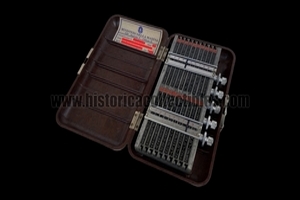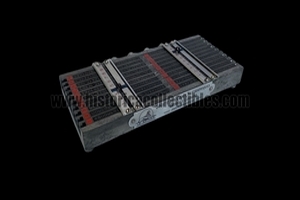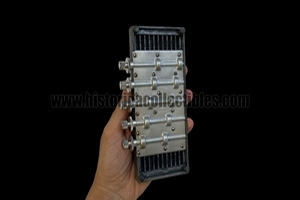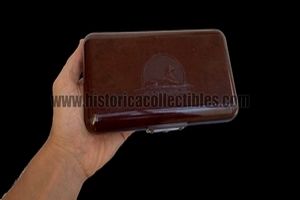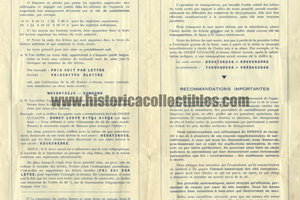Enigma "LE SPHINX" Pocket Cipher Device - The Sphinx, circa 1930
LE SPHINX pocket cipher device - The Sphinx - made by Societè des Codes Telègraphiques George Lugagne Paris-Marseille around 1930.
The device consists of a metal frame with ten lanes, each of which supports two movable rods with encrypted alphabets. The 20 transposed alphabets are identified by a number, imprinted in red, and are always used in pairs, with the upper alphabet representing plaintext and the lower alphabet used for ciphertext.
The rods can be moved by threaded knobs on the right side that engage the gears below. There are two fixed ruler windows for setting and reading plain text and ciphertext. The primary text is processed 10 characters at a time.
The device is based on the 1912 invention of a mechanical pocket transposition cipher device by Georges Lugagne of Boches-du-Rhône (Marseille, France), which was patented in 1913 as French Patent No. 461217. Around the same time, the device was patented in the United Kingdom as British Patent No. 23204.
The device was marketed in France by the Lugagne companies in Paris and Marseille, who had become famous for their 1914 international telegraph code books.
The image on the right shows the original 1912 design, which is mechanically less complex, but its operation is very similar. It consists of 20 paired encrypted alphabets, but they are not mechanically paired. The scroll rods are made of ivory.
In 1931, the design was improved by Lugagne employee Paul Godillon, who added the gears and 10 slotted knobs on the right side and the addition of the S-shaped blanks at each end of the alphabet rods, allowing the alphabets in pairs, freely mixing the upper and lower alphabets.
Godillon's invention was patented in France on February 4, 1931.
The same patent was filed in the USA on December 1, 1931 by Albert Gentet, who also added the moving index to each window. It is currently unclear where Le Sphinx was produced and by whom, but it is possible that it was produced by the famous slide rule maker BARBOTHEU in Paris, who also produced the Transpositeur in 1912. The latter is further described in an article by Daniel Tant.
Inside the device, there is a completed and registered inventory label, this label confirms the irrefutable proof that this device had been assigned to the Section of the most important Coded Message Decryption Office, within the Ministry of the Royal Navy in Rome, and available to the dedicated staff.
The workers in this Section achieved numerous and brilliant successes during the first part of the war period (1939-1943), knowing how to reconstruct ciphers through which it was possible to know in advance the movements of the naval and aeronautical fleets of the co-belligerent armies, neutralizing their possible and possible attacks on our country. It is necessary to remember in this publication, the Lieutenant Giorgio Verità Poeta, one of the chief cryptographers who was among the most significant figures belonging to this Section who, probably thanks also to the help of this device, managed to reconstruct a cipher used in French Navy for communications with patrol ships with over-encrypted telegrams.
The cipher device is in excellent used condition and comes in its original Bakelite box.
Bibliography:
Mario de Monte "Shadow Men" memories of a naval secret service officer - Nuova Editoriale Marinara Italiana - Rome - 1955
"Commander Giorgio Verità Poet" - 2016 Edibus Comunicazione srl
"Brief history of the Organization of the Information Services of the Royal Navy and Royal Air Force 1919-1945 - Ministry of Defense - 2013 - Maria Gabriella Pasqualini - Italian Commission of Military History

